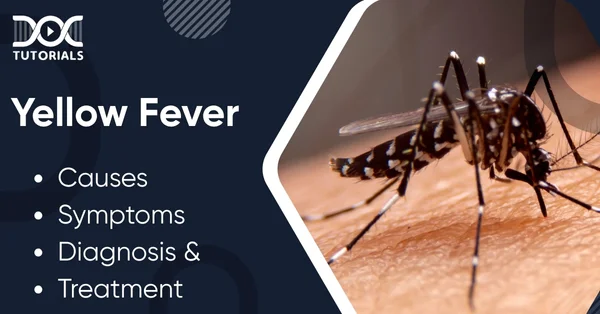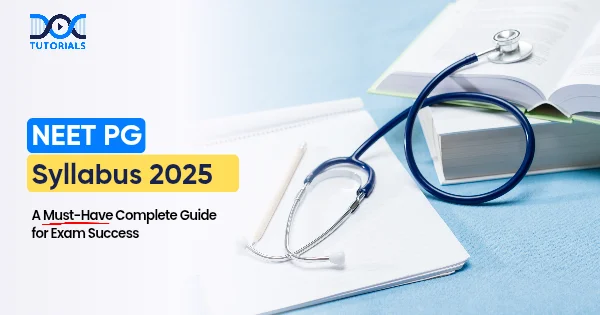Yellow Fever | Causes, Symptoms, Diagnosis, and Treatment

People in various parts of Africa and South America are more likely to get yellow fever, a serious viral fever. There is a vaccination for yellow fever, but outbreaks sometimes occur and can have severe effects.
Both doctors and the general public, especially those who live in or visit locations where yellow fever is common, need to know what causes it, how to recognise it, how to diagnose it, and what treatments are available.
If you want to become a NEET PG, continue reading to learn more about yellow fever’s causes, symptoms, risk factors, and treatment options. Because it is a required part of your syllabus, you need to know more about the subject.
What is Yellow Fever?
The Flavivirus genus contains the yellow fever virus, which causes yellow fever. This viral hemorrhagic disease comes on suddenly and causes a spectrum of mild to severe symptoms.
The name “yellow fever” comes from the jaundice, or yellowing of the skin and eyes, that some people with liver disorders get. Most of the time, the instances are mild or moderate, but some can worsen. People who survive yellow fever are usually immune for life.
What Causes Yellow Fever?
The yellow fever virus is primarily spread to humans through the bites of infected mosquitoes, notably the Aedes aegypti species. Mosquitoes and non-human primates (like monkeys) maintain the virus in a natural cycle.
- When mosquitoes bite infected primates, they can transmit the virus to humans.
- In urban areas, mosquito bites can quickly spread the illness.
- Rare transmission routes include:
- Blood transfusions
- Organ transplants
- Mother-to-child transmission during birth
- Blood transfusions
You cannot get yellow fever by touching or being near an infected person.
Risk Factors for Yellow Fever
Factors that increase your risk of contracting yellow fever or developing severe complications include:
- Living in or visiting regions of Africa and South America where yellow fever is common
- Being over 45 years of age
- Male gender (research shows higher fatality rates)
- Not being immunised
- Exposure to wooded or urban areas with mosquito activity
- Lab findings in severe cases:
- High AST (aspartate aminotransferase)
- Elevated INR (international normalised ratio)
- Increased lactate levels
- High white blood cell count
Symptoms of Yellow Fever
Symptoms usually appear 3 to 6 days after infection. The illness typically progresses through two stages:
First (Acute) Phase
- Sudden fever
- Chills
- Severe headache
- Muscle and back pain
- Nausea and vomiting
- Fatigue
- Loss of appetite
Most people recover within a week after this stage. However, some progress has been made to a more serious toxic phase.
Severe (Toxic) Phase
- Recurrence of high fever
- Jaundice (yellowing of the skin and eyes)
- Abdominal pain
- Vomiting, sometimes with blood (black vomit)
- Bleeding from the mouth, nose, eyes, or gastrointestinal tract
- Kidney failure
- Seizures and delirium
- Shock and multiple organ failure
The fatality rate in severe cases can reach 30% to 60%. Survivors typically develop lifelong immunity.
How to Tell If You Have Yellow Fever
Diagnosing yellow fever can be difficult due to similarities with other viral infections.
Clinical Evaluation
- Assessment of symptoms
- Travel history to endemic regions
Laboratory Tests
- ELISA (IgM) to detect antibodies
- RT-PCR to identify viral RNA (most effective in the first 10 days)
- Additional blood tests if symptoms present later
- Immunohistochemistry to confirm the diagnosis post-mortem using tissue samples
It is important to differentiate yellow fever from other flaviviruses (like dengue) and rule out recent vaccination as a cause of positive test results.
Treatment for Yellow Fever
There is no specific antiviral treatment. Management is supportive and includes:
- Rest and hydration: Essential for recovery
- Fever and pain management:
- Use acetaminophen
- Avoid aspirin and NSAIDs like ibuprofen or naproxen due to bleeding risk
- Use acetaminophen
- Hospitalization:
- Required in severe cases for:
- IV fluids
- Blood transfusions
- Treatment for organ failure
- IV fluids
- Required in severe cases for:
Prevention Through Vaccination
Getting Vaccinated
- The most effective method to prevent yellow fever
- Offers long-lasting immunity
- Recommended for people living in or visiting affected areas
Additional Preventive Measures
- Wear long-sleeved clothing
- Use mosquito nets and insect repellents
- Eliminate stagnant water around homes
Patients with yellow fever should avoid mosquito exposure for at least five days after symptoms begin to prevent the spread of the virus.
FAQs About Yellow Fever
- Can yellow fever spread from one person to another?
No, yellow fever does not spread directly from person to person. Infected mosquitoes transmit it through bites.
- How to avoid getting yellow fever?
Vaccination, mosquito control, and personal protection are key. Wear long clothing, use treated nets, and remove mosquito breeding sites near your home.
- What does yellow fever look like?
Mild cases resolve within a week, although fatigue may linger. Survivors typically gain lifelong immunity.
- Is yellow fever the same as malaria?
No. Yellow fever is a viral disease that can be prevented by vaccination, whereas a parasite causes malaria and is both preventable and treatable with medication.
- If you have yellow fever, when should you consult a doctor?
See a doctor if you develop fever or body aches after returning from Africa or South America, or if symptoms worsen after a yellow fever diagnosis.
Conclusion
Yellow fever is a dangerous but preventable disease. Vaccination, mosquito control, and public awareness are vital for reducing its impact in endemic areas and among travellers. Early detection and timely medical care can save lives; however, prevention remains the most effective strategy.
If you’re preparing for the NEET PG exam, you must understand yellow fever thoroughly. DocTutorials offers video lectures by top educators, regular tests to track your progress, and more.
Sign up for our NEET PG course today!
Latest Blogs
-

NEET SS Exam 2024: Analysis, Key Dates, Counselling
The NEET SS 2024 exam kicked off on March 29, 2025. Over two days and two slots, candidates across 13…
-

NEET PG Registration 2025: An Essential Guide For Exam Prep
The NEET PG registration, which is conducted online, is a crucial step in the exam process. Filling out the NEET…
-

NEET PG Syllabus 2025: A Must-Have Complete Guide for Exam Success
The NEET PG Syllabus acts as one of the foundation stones for aspiring postgraduate medical students like you who are…




